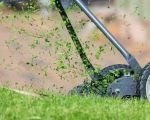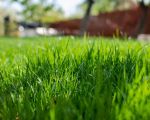
Lawn Care for Homes in Drought-Prone Areas: A Personal Guide
If you're a homeowner living in a drought-prone area, you know how challenging it can be to maintain a healthy, green lawn. With water conservation becoming more and more crucial, it's important to adopt sustainable lawn care practices. Over the years, I've learned some valuable lessons on how to care for my lawn while conserving water and keeping it looking great, even in the driest months. In this article, I'll share practical tips and strategies to help you keep your lawn thriving in these tough conditions.
1. Understanding the Challenges of Drought-Prone Areas
Living in an area prone to drought means that water restrictions and dry conditions are often a part of life. For many of us, this means that traditional methods of lawn care, like frequent watering, are no longer sustainable or even allowed. A few years ago, my own lawn was suffering from the constant heat and lack of rainfall. I started researching drought-resistant grasses and water-saving techniques, and the transformation has been incredible. The first step to successful lawn care in dry climates is understanding the challenges you face and finding ways to work around them.
2. Choosing Drought-Resistant Grasses
One of the first things I did to improve my lawn’s resilience to drought was to replace the grass with drought-resistant varieties. The right grass can make all the difference when it comes to water conservation. Some of the best options for drought-prone areas include Bermuda grass, zoysia grass, and fescue grass. These types of grass are known for their ability to withstand long periods of dryness and heat while maintaining a healthy, green appearance. They have deep root systems that allow them to access water more efficiently, and they require less frequent watering compared to traditional grasses.
When choosing the best type of grass for your lawn, be sure to consider your local climate and soil type. I found that fescue, for example, works best in cooler regions with less intense heat, while Bermuda grass thrives in the southern U.S. where the sun beats down most of the year. The right grass can help you save water and reduce the stress on your lawn during drought conditions.
3. Implementing Water-Saving Lawn Care Practices
Water conservation is key in drought-prone areas. I used to water my lawn every day, but I soon realized that this wasn't sustainable or necessary. Instead, I adopted a few water-saving practices that have made a huge difference. Here are some of the methods I recommend:
- Water deeply, but infrequently: Deep watering encourages roots to grow deeper into the soil, making your lawn more drought-tolerant. I now water my lawn deeply once or twice a week, depending on the weather, instead of watering lightly every day.
- Water early in the morning: Watering in the morning reduces evaporation and ensures that the water gets to the roots where it's needed most. I make sure to set my sprinklers to run early before the sun gets too hot.
- Use drip irrigation: Drip irrigation systems are an efficient way to deliver water directly to the roots of your grass and plants. Installing one around my yard has minimized water waste and kept my lawn green without over-watering.
4. Lawn Mowing Tips for Drought-Prone Areas
Another crucial aspect of drought-resistant lawn care is mowing. While it may seem like a simple task, mowing your lawn correctly can help it better withstand the heat. I used to mow my lawn too short, but now I always keep the grass a little longer. Taller grass helps shade the soil, keeping it cooler and reducing water loss through evaporation. Additionally, taller grass has deeper roots, which means the lawn can survive longer without needing water. I aim for a mowing height of about 2.5 to 3 inches, depending on the type of grass.
Another important tip is to mulch the clippings back into the lawn. Mulching helps retain moisture in the soil and provides nutrients that improve the overall health of the grass. This was a game-changer for me, as it not only saved water but also reduced the need for additional fertilizers.
5. Using Organic Lawn Care Products
As I looked into ways to improve my lawn care, I discovered that using organic lawn care products can help promote a healthy lawn without relying on harsh chemicals. Organic fertilizers, for example, provide essential nutrients to the grass while also improving the soil structure. Over time, organic products help the soil retain more moisture, which is particularly important during dry spells. I now use compost and natural fertilizers to keep my lawn healthy and strong.
Additionally, I’ve switched to using organic pest control methods. This reduces the chemical load on the environment and keeps my lawn ecosystem thriving, even during dry periods when plants are more vulnerable to pests.
6. Incorporating Xeriscaping Techniques
Xeriscaping is a landscaping technique that focuses on reducing water use by choosing plants that are naturally drought-tolerant. While my primary focus has been on lawn care, I've also incorporated xeriscaping principles into my garden. By choosing native plants and succulents, I have created a beautiful landscape that requires little water, even during the hottest summer months. These drought-resistant plants have helped me maintain a gorgeous outdoor space without worrying about water restrictions.
7. Addressing the Lawn’s Soil Health
The health of your lawn's soil plays a huge role in its ability to retain moisture. A few years ago, I learned that aerating my lawn regularly helps improve water infiltration and reduce soil compaction. Aeration creates small holes in the soil, allowing water to penetrate more deeply and reach the roots. This is especially important during drought conditions, as it helps the grass access the moisture it needs to survive.
In addition to aeration, I also apply a thin layer of organic compost to my lawn every year. This improves the soil's structure, helps retain moisture, and provides valuable nutrients to the grass.
8. Dealing with Drought Stress
During extreme drought conditions, it’s not always possible to keep your lawn looking perfectly green. However, there are a few things you can do to minimize drought stress. If your lawn begins to go brown, don’t panic—this is a natural response to lack of water. Instead of over-watering in an attempt to bring the grass back to life, give it time to recover. When rain returns or water becomes available, the grass will bounce back. I’ve found that keeping my lawn healthy throughout the year—by using drought-resistant grasses, reducing stress, and minimizing water usage—helps it recover quickly when the drought ends.
9. The Importance of Community Involvement
Living in a drought-prone area can sometimes feel isolating, but one thing I’ve realized is the importance of community involvement. By talking to my neighbors and sharing tips on drought-resistant lawns, I’ve been able to learn new techniques and even participate in local water conservation programs. Communities that work together can achieve greater water savings and help each other navigate the challenges of drought conditions.
For example, our neighborhood now has a program where we share lawn care tools and advice. By pooling resources, we reduce individual costs and work together to create a more sustainable environment for everyone.








